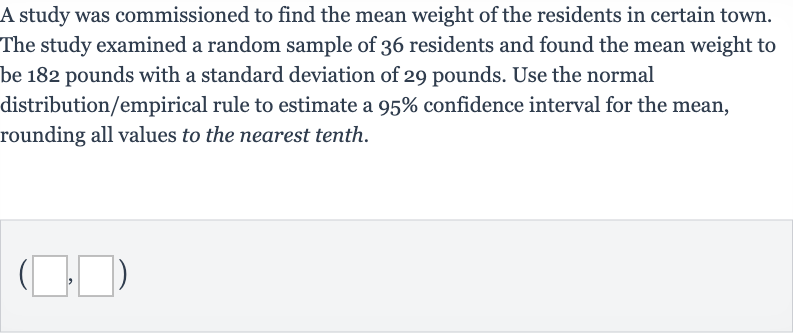AI tutor
Welcome to Bytelearn!
Let’s check out your problem:

A study was commissioned to find the mean weight of the residents in certain town. The study examined a random sample of residents and found the mean weight to be pounds with a standard deviation of pounds. Use the normal distribution/empirical rule to estimate a confidence interval for the mean, rounding all values to the nearest tenth.
Full solution
Q. A study was commissioned to find the mean weight of the residents in certain town. The study examined a random sample of residents and found the mean weight to be pounds with a standard deviation of pounds. Use the normal distribution/empirical rule to estimate a confidence interval for the mean, rounding all values to the nearest tenth.
- Identify Data Parameters: Identify the sample mean, standard deviation, and sample size. The sample mean () is given as pounds, the standard deviation () is pounds, and the sample size () is residents.
- Calculate Standard Error: Determine the standard error of the mean (SEM). The standard error of the mean is calculated by dividing the standard deviation by the square root of the sample size. Rounded to the nearest tenth, pounds.
- Find Z-Score for % Confidence: Find the z-score that corresponds to a confidence level.For a confidence interval, the z-score is typically (this value comes from standard normal distribution tables).
- Compute Margin of Error: Calculate the margin of error (ME). The margin of error is found by multiplying the z-score by the standard error of the mean. Rounded to the nearest tenth, pounds.
- Determine Confidence Interval: Determine the confidence interval.The confidence interval is calculated by adding and subtracting the margin of error from the sample mean.Lower limit = Upper limit = Lower limit = Upper limit = Lower limit = poundsUpper limit = pounds
More problems from Use normal distributions to approximate binomial distributions
QuestionGet tutor help
QuestionGet tutor help
QuestionGet tutor help
QuestionGet tutor help
QuestionGet tutor help
QuestionGet tutor help
QuestionGet tutor help
QuestionGet tutor help
QuestionGet tutor help
QuestionGet tutor help
